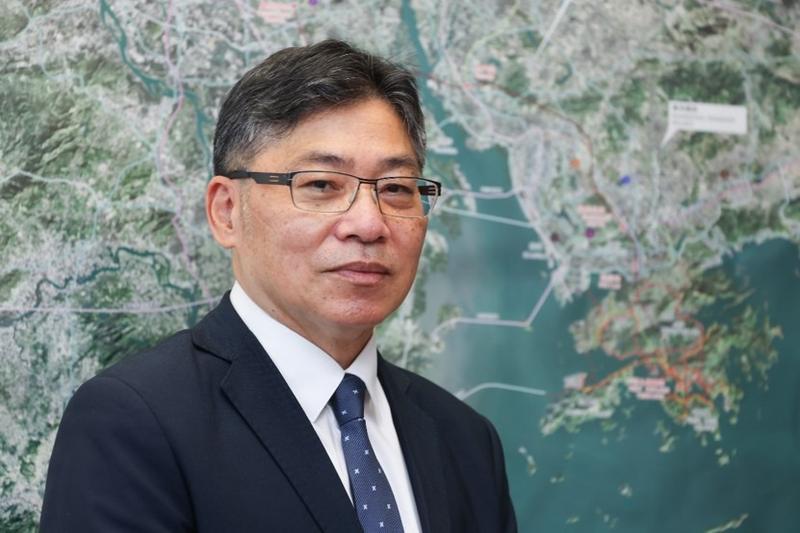'We'll be back to the golden age'

Hong Kong's deep links with the Chinese mainland, a business-friendly environment, and an efficient governance system will revitalize the local aviation and maritime sectors once the pandemic eases, with infrastructure projects and policy support paving the way for sectors' long-term growth, the city's transport chief tells Liu Yifan.

Editor's note: This is the first in a series of China Daily's interviews with the new heads of bureaus and other departments of the sixth-term administration of the Hong Kong Special Administrative Region. The heads discuss project plans, prospects, and ways to address the city's current issues and challenges from their perspectives.
More than 30 months into the COVID-19 pandemic, Hong Kong's battle-weary aviation and maritime industries are still struggling to deal with stringent travel restrictions and global supply-chain disruptions that have threatened the city's status as a global transport and logistics hub.
But Secretary for Transport and Logistics Lam Sai-hung remains undeterred by these uncertainties.
In an interview with China Daily, Lam, who took up the post on July 1 following the swearing-in of the Hong Kong Special Administrative Region's sixth-term administration, says Hong Kong's strong links with the Chinese mainland and the world, its business-friendly environment, and an efficient governance system offer the advantages that can help the local aviation and maritime industries bounce back when the pandemic eases.
While admitting that the road ahead is still rough, Lam believes the "right infrastructure and policies" — including the mammoth expansion project at Hong Kong International Airport that can boost both passenger and cargo capacity, the shipping tax concessions, and maritime-related training funds that can drive the growth of logistics services — will give full play to Hong Kong's competitive edges and take its airport and port back to the "golden age".
'Gradual recovery' vital
HKIA recorded a passenger count of 401,000 in July alone this year. Although the figure was a jump of nearly 260 percent year-on-year, it was only 6 percent of the pre-COVID-19 levels at the airport, lagging behind its regional counterparts that have seen increased flights after relaxing anti-pandemic measures.
But Lam is adamant that the SAR's aviation status hasn't weakened. Last year, HKIA handled 5 million metric tons of airfreight, still ranking as one of the world's busiest air-cargo centers.
Regarding the airport's lackluster passenger traffic, he stresses that a gradual recovery in airport activities is important, rather than a sharp rebound, in tandem with recruitment and training plans to avoid chaos.
The HKSAR government slashed the weeklong mandatory hotel quarantine for overseas arrivals to three days as of Aug 12. "It's a signal to the world that we'll greatly recover from the situation we've been in the past two years," Lam says.
Citing the chaos seen in North America and Europe, he notes that air travelers began rushing to airports as travel curbs are cut back, but acute staff shortages have led to flight cancellations, long lines and lost luggage.
"This is a lesson we have to learn," says Lam, adding that the Hong Kong authorities and airlines are planning very carefully to "keep services at a reasonable standard".
From a long-term perspective, Hong Kong is charting clear road maps to lift its status as a world transportation and aviation hub, as outlined in the nation's 14th Five-Year Plan (2021-25).
HKIA's third runway opened in July as part of a HK$141.5 billion ($18.03 billion) three-runway-system project that's due to be fully completed by 2024. Upon completion, the expanded airport will be capable of handling 120 million passengers and 10 million tons of cargo annually, compared with 70 million passengers and 4.8 million tons of cargo before the COVID-19 outbreak.
Along with the Hong Kong-Zhuhai-Macao Bridge artificial island and the Phase II development of AsiaWorld-Expo, these initiatives will help Hong Kong realize its decadelong vision of transforming HKIA into an "Airport City".
Lam says the projects demonstrate the city's resolve to bolster the aviation sector with a mission to better serve the Guangdong-Hong Kong-Macao Greater Bay Area — one of the world's wealthiest city clusters with a population 11 times that of Hong Kong.
Competing with neighboring airports is foreseeable, but Hong Kong's well-established global airline network is distinguishable from those of other airports in the region, which can create synergy among the cluster to lead the pack in the international arena.
The main challenge, Lam says, is to ensure that the policies to be implemented can cope with the development. "In this respect, I have to find the central government and the Guangdong (provincial) government in granting us the right policy at the right time. We are now on the right track to pursue it."
Scope to be extended
On Hong Kong's bid to reinforce its transport and logistics status, the maritime and aviation industries are equally important. According to the United Nations Conference on Trade and Development, more than 80 percent of the world's freight volume is carried by sea.
Strong headwinds nevertheless remain. Hong Kong's port reported a flat annual throughput of about 18 million twenty-foot equivalent units of containers last year. The city retained its position among the world's top 10 container ports, but its performance can't hold a candle to its peak a decade ago.
Lam, however, expects the demand for maritime services to grow robustly in Asia as the global economy's center of gravity shifts progressively eastward, while Hong Kong's 150-year maritime history has laid a solid foundation to capture the growing opportunities.
Leveraging its coverage of almost 600 destinations worldwide, he says the Hong Kong port is striving to extend its traditional shipping container business to high-value-added services, such as ship financing, marine insurance and dispute resolution.
To this end, the SAR now offers half-rate profits tax concessions at a rate of 8.25 percent to eligible ship agents, managers and brokers.
Lam's to-do list to facilitate the city's maritime transport development includes cultivating sufficient shipping-related professionals, digitalizing container port paperwork, and encouraging the use of environment-friendly fuels.
Lam, who retired as permanent secretary for development (works) in October and rejoined the HKSAR government after an eight-month hiatus, currently has given priority to "communicating with the transport and logistics industry".
After meeting with all the stakeholders, industry players and other related parties, he says he now has "a good understanding of the situations they're facing", and this will help him in future policymaking.
Describing himself as "young old" — both mentally and physically — the transport chief says his more than 38 years in the civil service have offered him a strong background for taking up his new role competently.
"With my experience in government for over decades, I'll apply my experience to new areas. That's why I'm here."
- Former senior official of Ningxia sentenced to death
- Development program narrows urban-rural gap in Guangdong
- Wuxi Winter Bazaar creates cross-cultural gathering
- Expressway service area featuring a natural hot spring to open soon in Guangdong
- Former Ningxia political advisor sentenced to death for bribery
- Former senior official of Jiangxi expelled from CPC





































